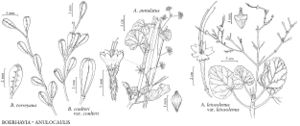Difference between revisions of "Boerhavia coulteri var. coulteri"
FNA>Volume Importer |
FNA>Volume Importer |
||
| Line 22: | Line 22: | ||
|elevation=[100-]500-1400 m | |elevation=[100-]500-1400 m | ||
|distribution=Ariz.;N.Mex.;Utah;Mexico (Sinaloa;Sonora). | |distribution=Ariz.;N.Mex.;Utah;Mexico (Sinaloa;Sonora). | ||
| − | |discussion=<p>Most plants of Boerhavia coulteri var. coulteri have fruit apices that are bluntly conic- or round-truncate. Along the Santa Cruz River particularly, some plants have abruptly truncate fruits; those plants represent the phase known as B. rosei. Early in the twentieth century, J. J. Thornber proposed the name “B. standleyi” for such plants but never published it. P. C. Standley (1911) described the ribs of B. rosei as narrow, adding in 1918 that the sulci were broad and open. As the type demonstrates, the relative breadth of the ribs and sulci is exactly the reverse, confusing regional botanists for several generations.</p> | + | |discussion=<p>Most plants of <i>Boerhavia coulteri </i>var.<i> coulteri</i> have fruit apices that are bluntly conic- or round-truncate. Along the Santa Cruz River particularly, some plants have abruptly truncate fruits; those plants represent the phase known as B. rosei. Early in the twentieth century, J. J. Thornber proposed the name “B. standleyi” for such plants but never published it. P. C. Standley (1911) described the ribs of B. rosei as narrow, adding in 1918 that the sulci were broad and open. As the type demonstrates, the relative breadth of the ribs and sulci is exactly the reverse, confusing regional botanists for several generations.</p> |
|tables= | |tables= | ||
|references= | |references= | ||
| Line 46: | Line 46: | ||
|publication year= | |publication year= | ||
|special status= | |special status= | ||
| − | |source xml=https://jpend@bitbucket.org/aafc-mbb/fna-data-curation.git/src/ | + | |source xml=https://jpend@bitbucket.org/aafc-mbb/fna-data-curation.git/src/8f726806613d60c220dc4493de13607dd3150896/coarse_grained_fna_xml/V4/V4_42.xml |
|genus=Boerhavia | |genus=Boerhavia | ||
|species=Boerhavia coulteri | |species=Boerhavia coulteri | ||
Revision as of 17:28, 18 September 2019
Stems 2–8 dm. Leaf blades 10–50 × 6–32 mm. Flowers: pedicel 0.2–1.6 mm; bracts at base of perianth usually 2; perianth 1–2 mm distal to constriction; stamens 2–3(–4), slightly exserted. Inflorescences terminal clusters, axis 15–60 mm. Fruits (4–)7–20(–22) per cluster, usually overlapping by 50–100% of their length, or 2–4 in group, separated by small gap from next group and with distal fruits overlapping, pale tan, narrowly obpyramidal, 2.5–3.2(–3.6) × (0.9–)1.1(–1.4) mm (l/w: [2.2–]2.5–3.1[–3.3]), apex bluntly conic-truncate, round-truncate, or truncate; ribs obtuse, each often with sharp ridge, slightly rugose near sulci; sulci 0.1–0.2 times as wide as base of ribs, slightly rugose.
Phenology: Flowering late spring–early fall.
Habitat: Sandy or loamy soils in arid grasslands, among brush, roadsides in deserts and cultivated areas
Elevation: [100-]500-1400 m
Distribution

Ariz., N.Mex., Utah, Mexico (Sinaloa, Sonora).
Discussion
Most plants of Boerhavia coulteri var. coulteri have fruit apices that are bluntly conic- or round-truncate. Along the Santa Cruz River particularly, some plants have abruptly truncate fruits; those plants represent the phase known as B. rosei. Early in the twentieth century, J. J. Thornber proposed the name “B. standleyi” for such plants but never published it. P. C. Standley (1911) described the ribs of B. rosei as narrow, adding in 1918 that the sulci were broad and open. As the type demonstrates, the relative breadth of the ribs and sulci is exactly the reverse, confusing regional botanists for several generations.
Selected References
None.
